How to fish the Glide Pool on the Welsh Dee at Llangollen
Table of Contents
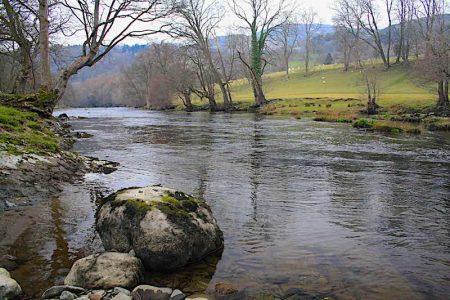
The Glide Pool Introduction
I’ve produced this fly fishing guide to share my knowledge on how to fish the Glide Pool, which includes fishing the riffle above the main pool.
The main pool is a short section of water that runs over a rock platform that, over the millennia, has eroded channels into it.
Salmon lie in the deep channels because, in low water, they are fed with oxygenated water from the upstream riffle section.
Trout and grayling lie in the riffle section and throughout the main pool especially, in the drop-off zone at the head of the main channel close to the left bank.
Fly Fishing for trout & grayling:
The river flows south-easterly through the Glide pool and is shaded from the sun by the large trees on the right bank. Therefore, on sunny days the main pool fishes well throughout the day. However, mornings and evenings are the best times to fish the riffle section.
The Glide Pool is fishable from both banks, but it’s mainly fished from the right bank because it allows access to the other pool on the Upper beat.
I only fly fish the Glide Pool when the river level is below 0.7m (Corwen gauge); above this height, the river flows too quickly through the pool.
I have highlighted where I usually catch trout and grayling on the following sketch of the Glide Pool.
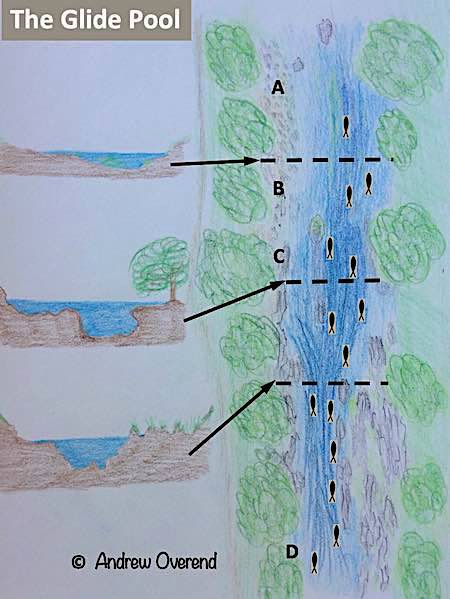
The area between points A and B above the main pool is a wadeable, shallow riffle. The riverbed there consists of a mixture of gravel and hand-sized pebbles.
However, near the end of the riffle, there are a few submerged areas of smooth slate bedrock that are very slippy.
The main pool starts at point C, where the river flows over a rock platform. Fish lie in the deep channels that have been cut into the rock down to point D.
I fish this part of the pool from the safety of the bank because it’s too treacherous to set on to the wet slippy rocks.
There are several possible approaches to fish the Glide Pool. For this guide, I’ve chosen those helpful to someone who has not fished this pool before.
Fly fishing the riffle (section A to B):

When the Welsh Dee is at its summer level (0.5m Corwen gauge) the riffle is less than 4ft deep. Thus, a great place to fish for trout and grayling fishing with any fly fishing methods.
During the summer months, large patches of Water-cowfoot (weed) grow in the riffle, which provides good lies of trout and grayling.
The weed makes it difficult to fish this section because of fouling and guiding hooked fish around the weed to the net.
However, your effort can be rewarded with some quality grayling. Fishing upriver from point B to A often yields the best results.
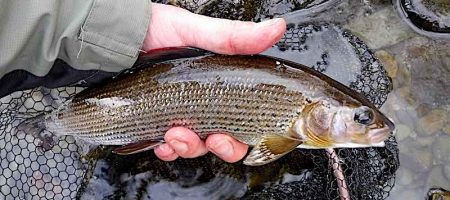
I approach fishing the riffle section on warm days with wet or dry flies. If that doesn’t produce anything, I will rest it for 20 minutes and fish it again with a team of nymphs.
Fly fishing the main pool (section C to D):

For beginners, it is best to start fly fishing at point D (the tail) with the dry fly, and fish upriver to point C. Taking care not to slip on the rocky bank.
Trout and grayling, normally, hold in the foam lines and this is where you should focus your fishing as you move upriver.
If fish aren’t rising try fishing a nymph suspended under a dry fly (Klink & Dink style).
How my approach changes with the season:
How to fish the Glide Pool in March:
The brown trout fishing season on the Welsh Dee starts on the 3rd March. However, the weather in March is often more like winter than spring.
On mild days, hatches of large dark olives and March Browns usually start around 11 am and you will often spot trout picking them off as they drift through this pool. During these hatches, my approach is to target rising trout with the dry fly (large dark olive or March Brown pattern).
Alternatively, fishing a team wet flies on a floating line often yields some beautiful over-wintered brown trout. The following is one of my default team of wet flies/spiders.
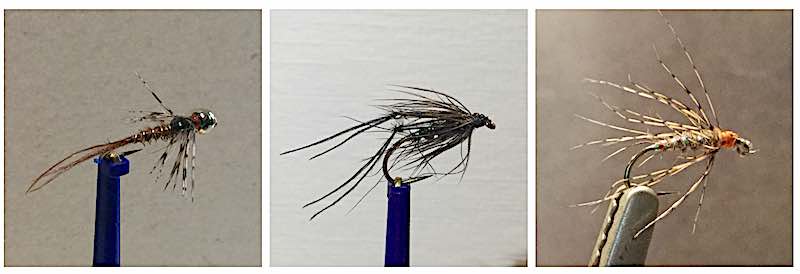
If either of the above fails, I will try my luck fishing the pool with a couple of nymphs suspended under a sight fly (Klink & Dink method).
For more information on the fly selection for fishing during March check out the following article:
How to fish the Glide Pool in April:
Once April arrives, the weather usually starts to warm up and hatches of Large Dark Olives, March Brown, Grammon and other olives become more prevalent from mid-morning to mid-afternoon. Hence, providing more opportunities to catch brown trout on the dry fly, by matching the hatch.
More information on the fly selection for fishing during April is covered in the following post.
How to fish the Glide Pool in May:
As the weather warms and dries up during May, fly hatches become prolific and brown trout become egaer to fatten up on the emerging fly life. Examples of flies you will see include:
Up-winged flies:
Sedges:
- Black sedge
- Grannom
- Cinnamon sedge
- Medium sedge
Others:
- Hawthorn fly
- Alderfly
- Large stonefly
- Midges
As a result of all the fly-life, May is when dry-fly and upstream wet-fly fishing produce the best catch results, when you have identified which flies the trout are taking.
On overcast days, the fishing can be good from morning to dusk.

More information on the fly selection for fishing during May is covered in the following post.
However, on sunny days the fishing dies off between 11 am and 5 pm because there is a lack of shade on this pool and the sun is behind you.
How to fish the Glide Pool during June to September:
When the river is low during the summer months, fast, oxygenated water at the head of the Glide is a good place to fish. On sunny days, the best fishing is early in the morning and after 5 pm.
More information on the fly selection for summer is covered in the following posts.
How to fish the Glide Pool in October:
My attention turns to grayling fly fishing from October to the end of February on the Welsh Dee.
During autumn and winter, river conditions often dominate my grayling fishing activities and I will only fish this pool if the river is running clear and the level is below 0.7m (Manley Hall gauge).
During October on the Welsh Dee, fly hatches are still common on most days. The flies you are likely to see hatching include:
- Large Dark Olive
- Iron Blue Dun
- Pale Watery Dun
- Caparer
- Midges
The approach to fly fishing the Cottage Pool depends on river height, water and weather conditions. October mornings tend to be cool and fly hatches don’t usually start until mid-morning.
Before 10 am I will start fishing the pool from the bank by casing a team of wet flies across to the far bank and allowing them to swing round to the dangle.
My default wet fly recommendation is the following team of three flies cast on 3lb copolymer (point: #14 March Brown spider; middle dropper: #14 black hopper; top dropper: #16 claret spider).
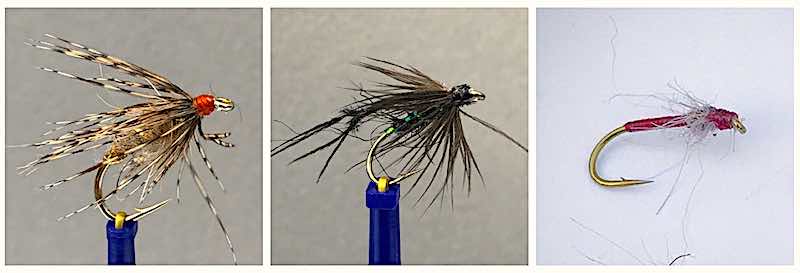
Once flies are observed hatching I will switch to targeting rising grayling with the dry fly. Ideally, it’s best to try and identify the flies that are being taken and tie on a suitable imitation.
If that is not possible, I usually start with a CDC olive emerger pattern that has served me well, and if that doesn’t work I start working through my fly box. However, it’s rare not to catch a grayling on one of the three following patterns:

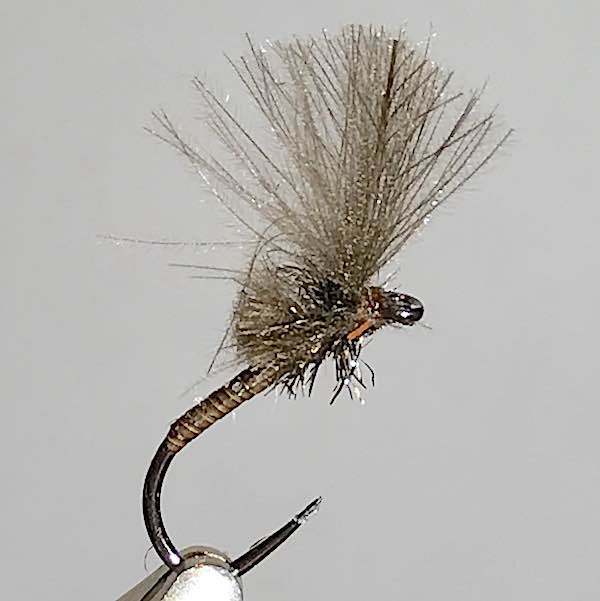

On rare occasions it’s not possible to tempt grayling with either of the above approaches, it is necessary to switch to fishing nymphs close to the riverbed.
Check out the link below for additional reading on flies for October:
How to fish the Glide Pool in November:
The clocks go back at the end of October and the days get increasingly shorter during November.
With aquatic life becoming dormant for winter, fly hatches are sparse, and grayling are increasingly searching the riverbed for food: nymphs, larvae, worms, etc.
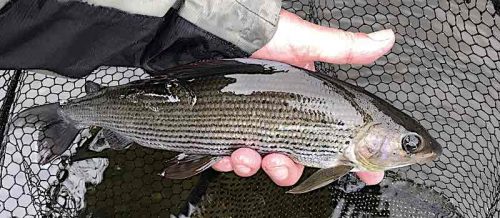
The clocks go back at the end of October and the days get increasingly shorter during November. With aquatic life becoming dormant for winter, fly hatches are sparse, and grayling are increasingly searching the riverbed for food: nymphs, larvae, worms, etc.
Fishing for grayling during November can be great sport because they have to feed hard to ensure they are in peak condition for spawning in spring.
On November mornings fishing a team of nymphs under a bung often yields the best results.
Sporadic hatches of olives usually occur around lunchtime on mild days. If this happens then switching to fishing dry or wet flies often is the best approach.
For more information on the flies to use on the Welsh Dee during November check out the following article:
How to fish the Glide Pool December,January & February:
Once winter sets in, the Welsh Dee is more often than not in flood during the winter months and the opportunities to fish the Glide Pool diminish.
If the river level is below 0.7m (Manley Hall gauge) it is, however. worth fishing for grayling because they start to shoal in the pool before spawning in the spring.
My approach to fishing this pool during the winter months is very similar to that used in November.
For more information on the flies to use on the Welsh Dee during winter check out the following articles:
Fly fishing for sea trout:
During July the pools near Llangollen become to be populated with sea trout and a few rest up in the Glide Pool during their journey upriver.
I rarely fish the Glide Pool for sea trout after dark because bank is too hazardous. However, I do fish the pool for sea tout during the last couple of daylight using small wet flies for the last hour of daylight.

When you get a take, once you have set the hook, you just have to let the fish take off until you know what’s on the end of the line, since it’s just as likely to be a big grayling or brown trout than a sea trout.
The sea trout I’ve caught fishing the Glide Pool have not been large (i.i.e.,e. 1 to 2lbs bracket) but they still are great sport.
Fly fishing for Salmon:
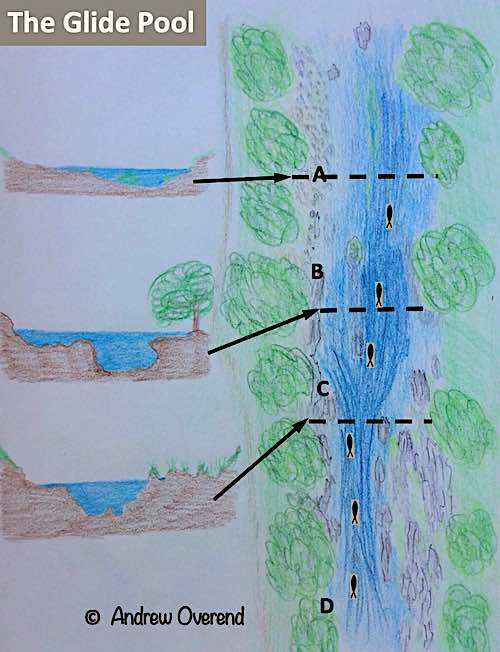
Most years, I’ve seen the odd salmon jumping in the Glide Pool but they are not easy to catch on the fly.
To help you with where to focus your salmon fishing activities in the Glide pool I have produced the following sketch show where the typically jump.
It’s difficult to fish all of the pool with the salmon fly. From late August onward when the river level is below 0.7m, I focus my efforts fishing between points A & B, and C & D.
I use either use a floating line with a 12ft copolymer tapered leader (12lb tip) or a 10ft sink-tip line when the river is slightly coloured.
The lies between B and C are difficult to cover with the fly and are best fished with the spinner.
For fly selection, I normally follow this simple approach:
In coloured water a size 10 or higher brightly coloured fly (e.g. Cascade, Park shrimp etc).

In clear water, I use size 10 or smaller drab coloured flies (e.g. Stoats tail, Blue Charm, etc)
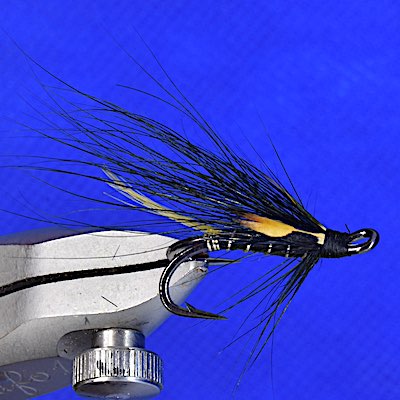
Where do I get day tickets?
Day tickets to fish the Glide Pool are obtained from the Llangollen-Maelor website (Tariffs).
Please contact the club for additional advice on fishing the Welsh Dee at Llangollen, they will be happy to help you.
How to get to the Glide Pool?
From Llangollen take the A5 to Crown then just after the junction with the B5103 by Berwyn Station take the next right and follow the lane for about 1mile. At the end, you will see the top car park on your left.
Walk up the lane from the car park to the style on the right that takes you into the field. Continue upriver for about 200 metres and The Glide is just above the telegraph pole.
Fishing, like most outdoor sports, is not without its hazards. Therefore, YOU MUST DO YOUR OWN RISK ASSESSMENT before starting to fish. Especially if you decide to wade and/or fish at night. In addition, you must follow the Llangollen-Maelor Club Rules when accessing and fishing this water.